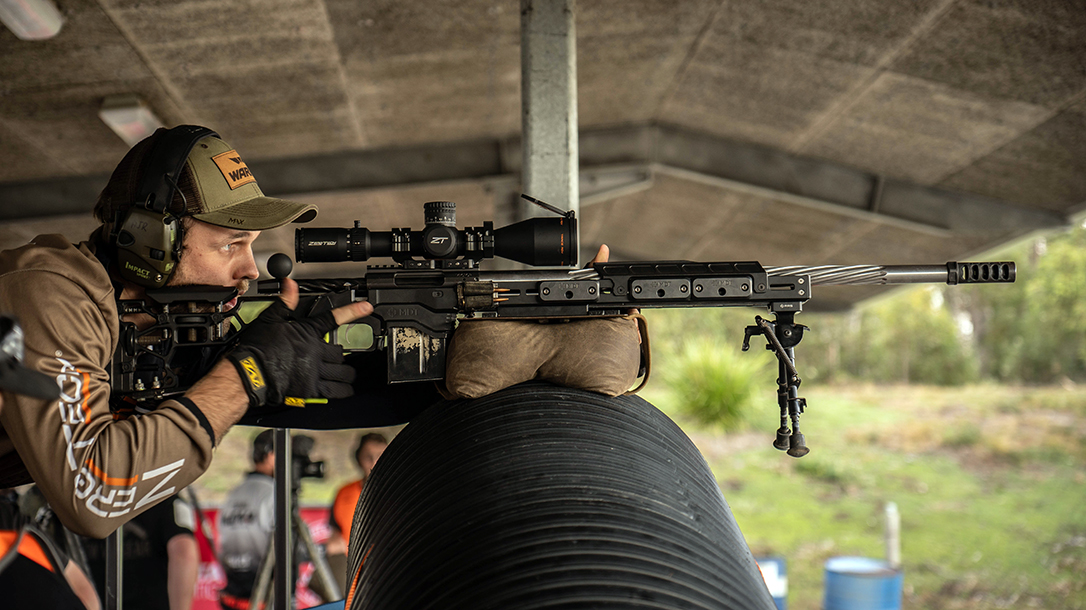Whenever a friend or family member gets a new rifle, they always ask me what optic, accessories, or long-range tools I recommend they get. My response is always the same. “What is the purpose of your rifle? How do you plan to use it?” In my world of competitive shooting, rifles see use in multi-gun shooting sports, the Precision Rifle Series (PRS), National Rifle League (NRL), gas gun series matches, The Tactical Games, Proving Grounds, AK matches, and more. Meanwhile, non-competitors, including hunters, might take a shot on a big-game animal out to 400+ yards. And some people just want to shoot their rifles past a few hundred yards because they can, and it’s fun. So it pays to match your long-range gear to whatever your shooting pursuit.
Match Your Long-Range Gear to Specific Activity
Once you know the purpose of your rifle, you then need to match your gear to that activity. Regarding long-range rifle shooting, there are a few universal tools every rifleman should own. After that, I recommend specific optics, accessories, and gear based on the shooting sport (and division), the type of animal hunted, or long-range shooting goals someone has. My final piece of advice is that less is usually more. Find out what works for you and master using it. I’ve seen some of the best shooters overwhelm themselves with too much gear and not focus on their goal of hitting their targets.
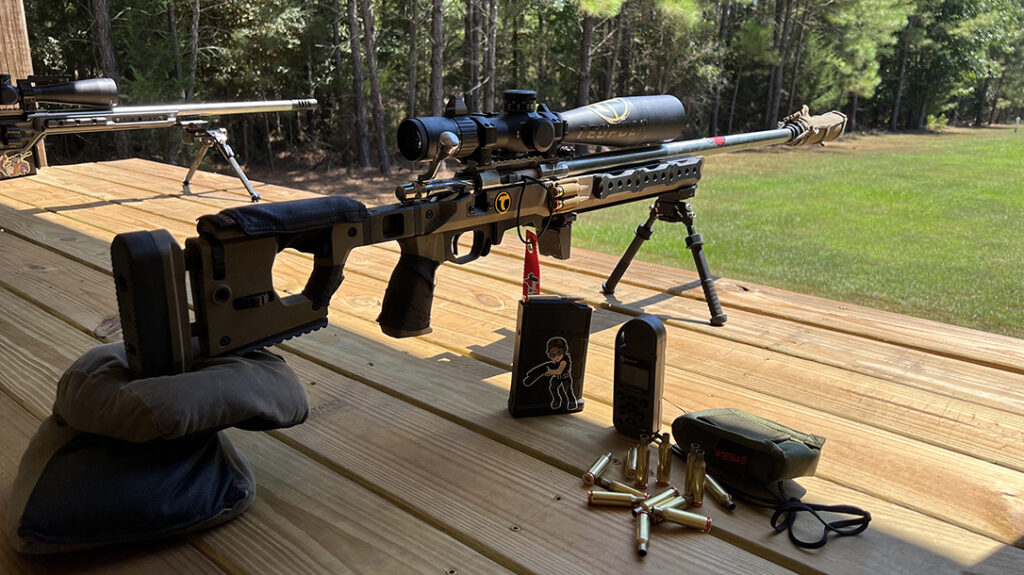
Advertisement — Continue Reading Below
Long-Range Shooting Must Haves
Kestrel Ballistics Weather Meter
I recommend the Kestrel 5700 Elite for all riflemen wanting to shoot their guns past 200 yards. This one tool, with the correct information inputted, will do all the math and science to calculate what you need to do to hit your intended target. A Kestrel will measure wind and air density to calculate elevation and windage outputs. There is a lot more to this device, including the Applied Ballistics bullet library with custom drag models, Target Cards, and a Ballistics Data Table, as well as the ability to store up to 30 gun and bullet profiles and 10 saved targets. The weather mode of this device reads wind speed, temperature, humidity, pressure, and altitude.
The environment you shoot in is a critical component that affects bullet performance. This is why you should always check zero (and re-zero if needed) when you travel to a new place with your rifle, capture chronograph readings to get your average velocity and confirm your data as far as you need to shoot. The Kestrel works with any gun or targeting scope and your choice of solution units (Mils, true MOA, Shooter’s MOA, or clicks).
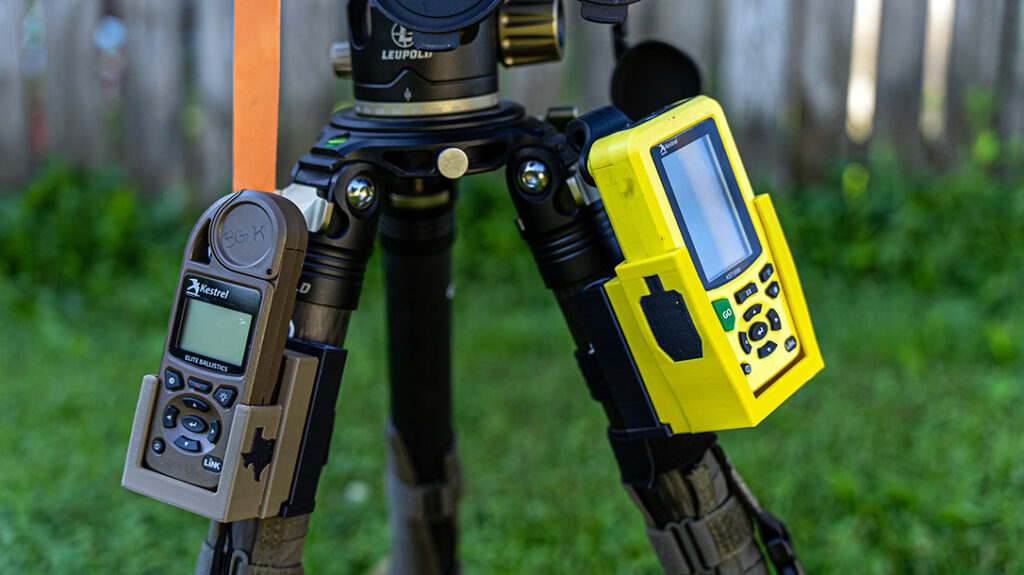
Advertisement — Continue Reading Below
Kestrel Holster
You’d be surprised at how easy it is to lose track of your Kestrel. I use the ConlanClanPrints Kestrel 5700 Weather Meter Holster to attach my Kestrel to my tripod, which is my “command center.” My tripod is where I mount my Kestrel Heads Up display, Leupold BX-5 Santiam HD 15x56mm binoculars, and wind flag. I use the Cole-TAC Tripod Leggings with the shelf, water bottle holder, and brass bag attached, so I have everything I need in one place. The Kestrel holster comprises a 3D printed design custom-made to your tripod leg dimension. The best part is the mount can stay on the tripod while the holster can slide up and off so you can use your Kestrel quickly off the tripod. I also use the Kestrel KST1000 Shot Timer holster to keep track of it, as I use that timer for every shooting sport.
Chronograph
A chronograph and a Kestrel go hand in hand. Both tools are only helpful when used together. In my Chronograph Guide, I shared three of the top devices used nowadays, some old-school ones and a newer model coming soon. A chronograph will track a bullet’s velocity, which is essential information you must input into your Kestrel to calculate the elevation needed to hit a known distance target.
A chronograph will also reveal information about ammunition, including an average, the spread, standard deviation, and minimum and maximum for all shots fired in a series. Whether you reload ammunition specific to your rifle or shoot factory ammunition, you should always chronograph the “batch” or “lot” of ammunition to test for extreme variances from one round to the next. If you plan to shoot factory ammunition, always purchase ammo in “bulk” or “lots,” so the ammo is as consistent as possible from round to round. If you buy the same ammo, say six months or a year later, that “lot” of ammo needs to be chronographed. Usually, the average velocity will change from lot to lot, and that small change matters in the world of long-range shooting.
Advertisement — Continue Reading Below
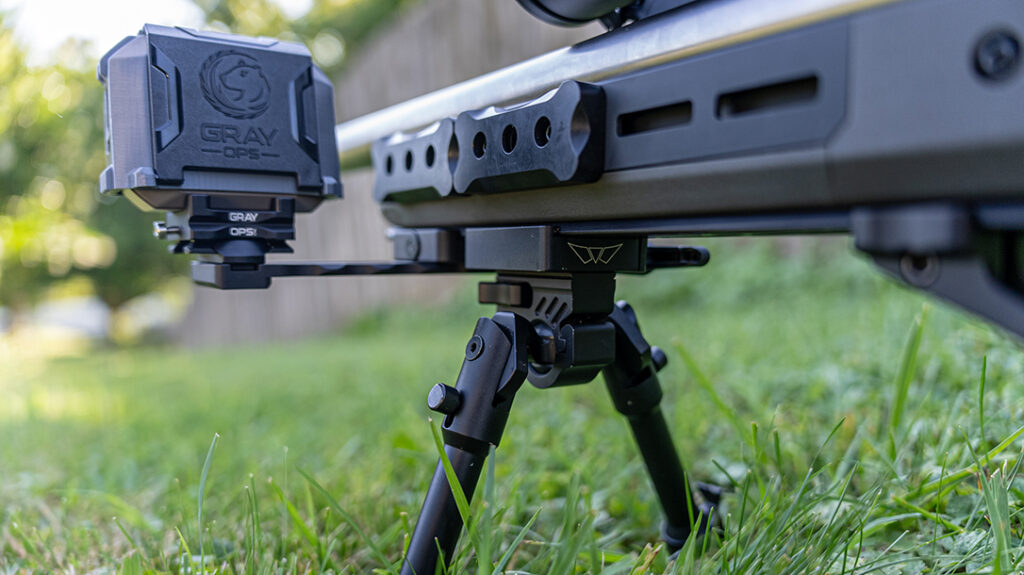
Bipod
Every rifle needs a sturdy bipod with a way to attach it to the gun. For competition rifles, I recommend using a QD-style mount to take the bipod on and off the gun quickly. Most hunting rifles are limited in options, as the style of rifle usually dictates the compatible bipods. A bipod is an investment, but if you do it right, you should only have to make it once. Sturdy bipods built for long-range shooting can vary in price from $400 to upwards of $1,000.
With as much shooting as I do, I run one bipod brand to master its functionality. I use the same Warne Scope Mounts bipod for my ARCA rail PRS/NRL rifles as I do with my Picatinny rail-equipped multi-gun rifles. I purchased one of each interface to simplify my life so I wouldn’t have to use a head adapter kit to swap between styles. A good bipod for long-range shooting should have multiple height adjustment increments, retractable legs, a wide cant range, variable-width stance angles, and more. The easier and quicker you can deploy these functions, the better. MDT, Atlas, and Accu-Tac make some great bipods for long-range shooting, especially in the competition world, where you will learn to use a bipod for more than just prone shooting.
Advertisement — Continue Reading Below
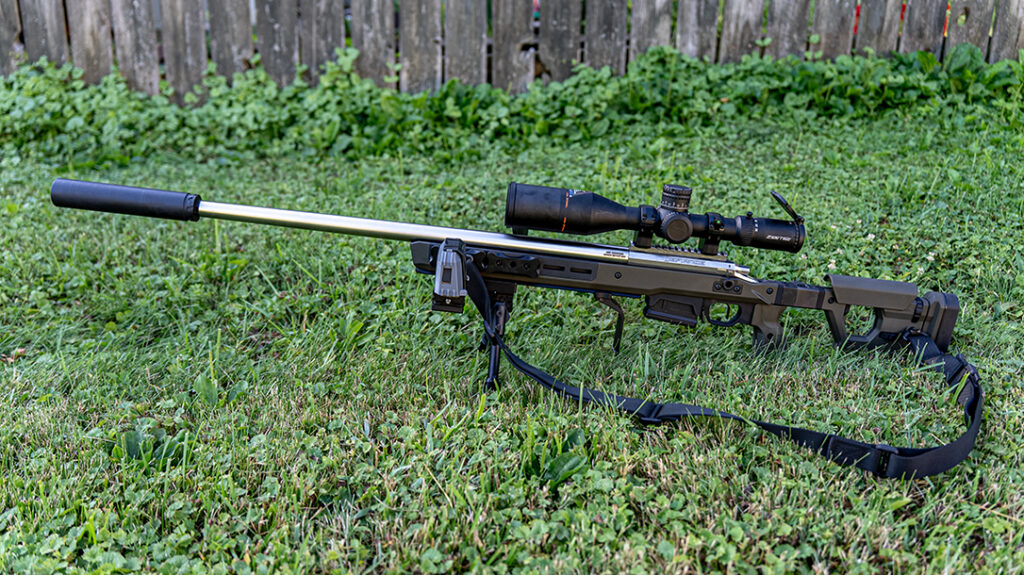
Support Bag(s)
This is where “less is more” really comes into play. And here’s the number one thing you need to take away from this: YOU, and only YOU, can choose what support bag(s) work for you. A rear bag is crucial to eliminate as much movement from the rifle as possible when shooting prone. A solid support bag for shooting off props and barricades must stabilize, level, and help align the gun to the target.
Bags must also be tailored to the activity, meaning hunting, competing, or plinking. Most hunters who hike in and out or stalk hunt for days will want as little weight as possible, which means a lightweight bag is best. For PRS or NRL shooting competitions, using a 10–15-pound bag for positional and rear support is normal. In most of my 3-Gun shooting competitions, I must start with all gear in hand, so a lightweight bag is the right match for that activity. I recommend Wiebad Gear fortune cookie bags and choosing the fill type based on your activity.
Advertisement — Continue Reading Below
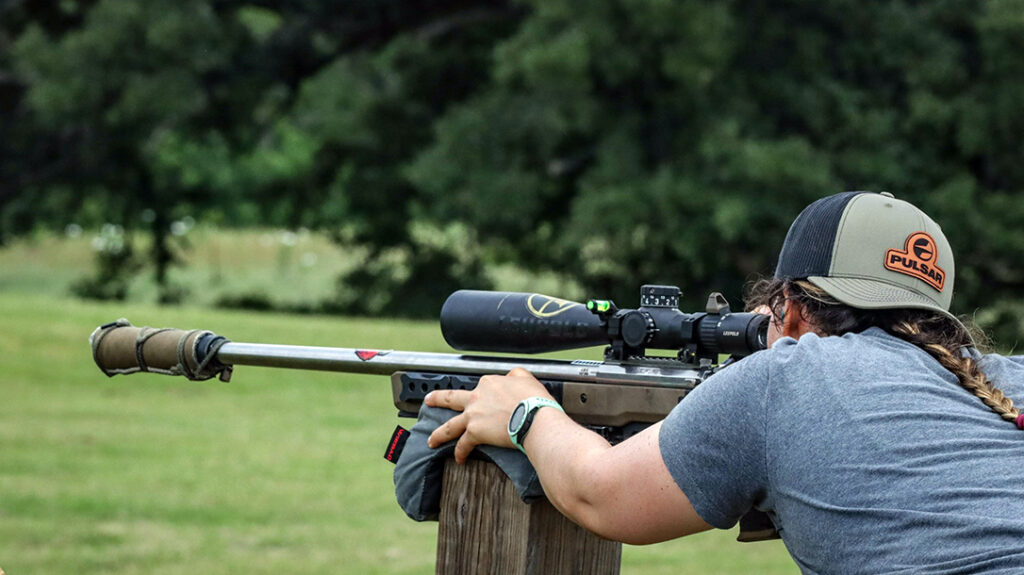
Range Finder
Every rifle shooter should own and know how to use a range finder. Most optic brands make a range finder, either a mono-handheld device or binoculars with a built-in range finder. If you don’t know the distance of your target, it’s really hard to shoot it successfully.
VERTX Overlander Backpack
When I started shooting PRS matches, I thought carrying that gear would be much easier than carrying my 3-gun gear. Less gear is required, but the weight difference between sports is astronomical. I knew the Vertx Overlander Backpack would be durable enough to use in rain, snow, and extreme heat and that it could be set on gravel, clay, and grass without damage. The amount of storage and weight load it can carry makes it the real winner.
Advertisement — Continue Reading Below
Scope Matching
To match a rifle with the proper scope, you must know how you intend to use the firearm. These are the factors I use to choose a quality scope for the specific job.
Clarity of Glass
If you can’t see your targets, you’ll have an even better challenge hitting them. A long-range scope needs good, clear glass with a wide field of view. Don’t be the person who invests in a great rifle and skimps on glass. The clarity of the scope you look through will help you see your impacts on target, but more importantly, it will help you spot your misses to make corrections on the fly.
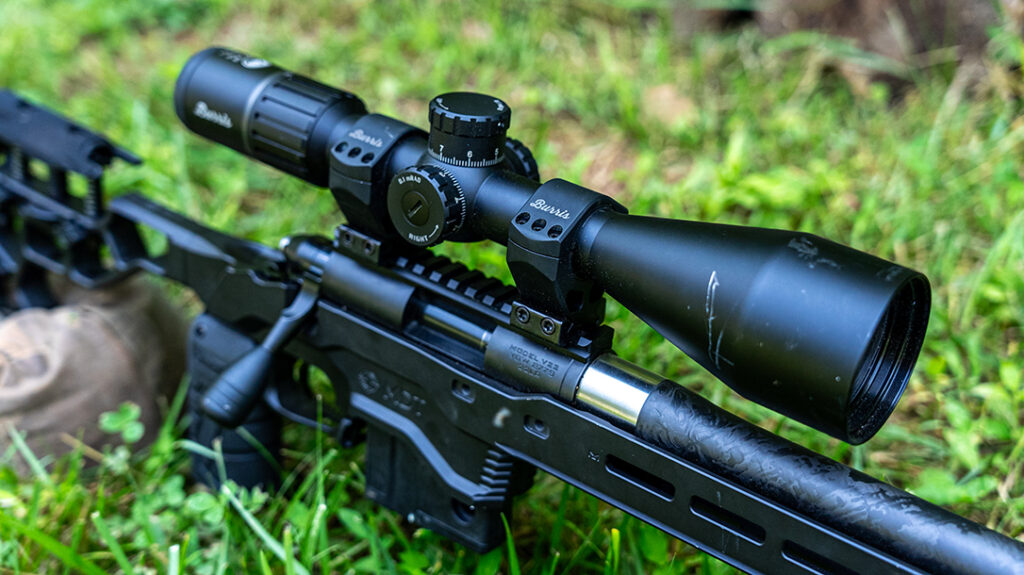
Advertisement — Continue Reading Below
Magnification
The magnification level you need directly correlates to the distances you want to shoot and the target sizes. For shooting targets at a maximum of 500-700 yards in multi-gun shooting competitions, the 1-8 and 1-10 magnification level scopes will serve you well. For NRL22 shooting competitions, many shooters will start with a 3x or 5x magnification level and max out anywhere from 18x to 25x or 35x. The magnification for this sport is less used to see far targets but more about seeing tiny, quarter-inch targets 100 yards away. PRS scopes typically start at 5x or 7x magnification and max out between 25x and 35x.
Pro Tip: After years of shooting long-range targets, I learned never to max out the magnification ring, no matter what scope you’re using, the sport you’re shooting, or the hunt you’re on. When I use my 1-8x scope, I typically only go as high as 6x power. For my 7-35 scope, I rarely go over the 19x power. Maxing out the magnification range can limit your field of view, make finding your next target extremely difficult, and prevent you from spotting your misses. Always buy more magnification than you need.
Reticle
The reticle is just as important as the scope you choose. I highly recommend using MILs instead of MOA, but you should use whatever works for you. Some scopes have “tree” reticles that look like Christmas trees and are designed to make holding for elevation and windage quick and easy. An illuminated reticle is not as crucial in long-range shooting unless you plan to compete in night competitions (they do exist).
Advertisement — Continue Reading Below
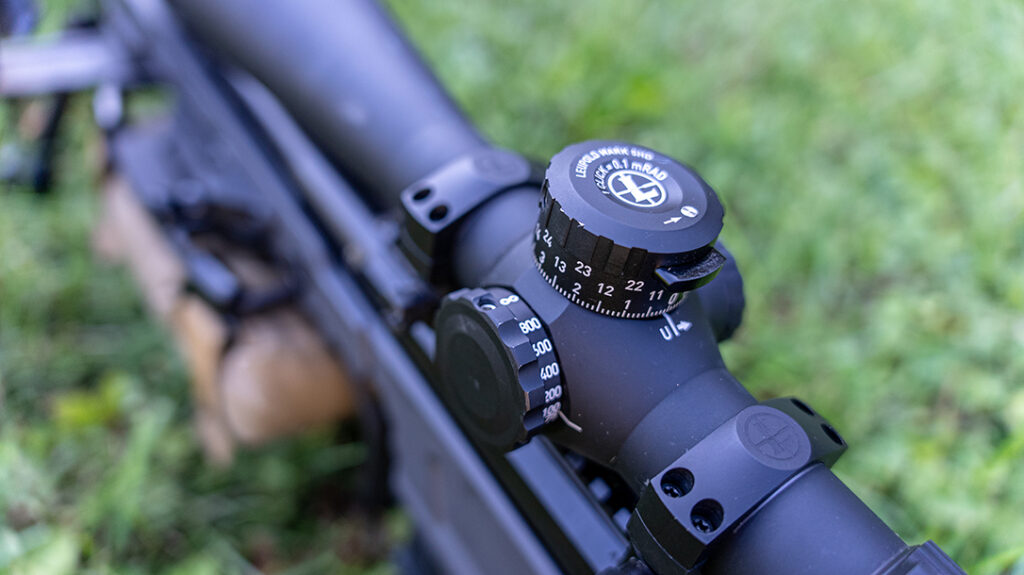
Scope Recommendations
Trijicon Credo 1-8×28 MRAD—I have used this scope in 3-Gun competitions for years. In 3-Gun, you will hold for elevation most of the time, and this reticle makes it simple to understand where the holds are.
EOTECH Vudu 1-10×28 SR5 MRAD—This scope is mighty! Its reticle is designed for long-range shooting, but it also incorporates the EOTECH illuminated circle to make shooting close-range targets fast. As we shoot further in 3-Gun competitions, I’m about to move to the 1-10x magnification level, which I recommend new shooters coming into the sport go ahead and start with.
Leupold Mark 5HD 7-35×56 PR2 MIL—This is my go-to scope for Precision Rifle Shooting and what I competed with in my first year of long-range competitions. The PR2 reticle took me a few months to understand, but it all made sense once I understood the tenths wind holds and the MIL increments and started impacting moving targets. For PRS, you dial many elevation changes for targets, but there are occasions where holding is faster, so it’s essential to know your MIL increment marks.
Zero Tech Optics Trace Advanced 5-30×56 RMG2—This scope is also built for PRS or long-range shooting. It is made of Japanese glass and is a first focal plane scope with an easy-to-understand reticle. There is a zero-stop function, a must-have in PRS, and the turrets are easy to dial and adjust quickly. The RMG2 reticle has extended windage and elevation on the “tree” reticle design, making it a good scope option for NRL22.
Burris RT-25 5-25×56 SCR2—Some shooters spend thousands of dollars on their NRL22 rifle and scope. Since it’s not a sport I shoot much of, I found a quality scope that was budget-friendly but powerful enough to do the job. The SR2 reticle has a “tree”-style reticle that is a must-have for shooting 22LR because of the frequent wind adjustment holds you will have to make. You can dial for windage, but having a tree reticle to make corrections on the fly when the wind changes in the middle of a stage is best.
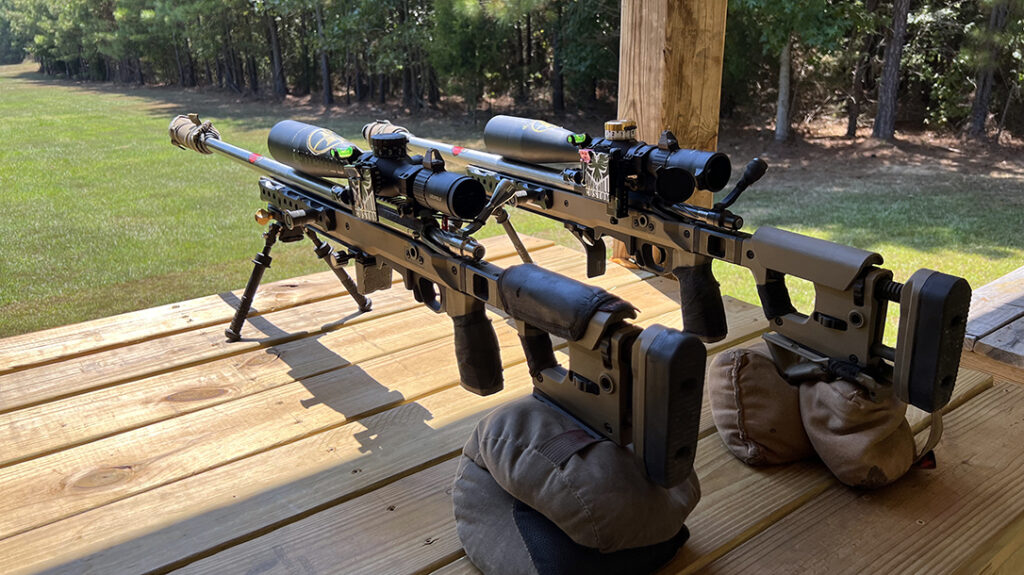
Helpful Extras
I recommend a few final tools if you’re dedicated to mastering the art of long-range shooting or going out and competing. Having a quality set of binoculars will allow you to watch the trace of bullets as they impact or miss targets. I highly recommend a bubble or electronic level somewhere on your long-range rifle to tell you if there is any cant in the gun before you pull the trigger. Any cant in the rifle will affect the bullet’s trajectory at long-range targets. Gray Ops external weights are a must-have to balance out your rifle if it’s too bottom-heavy—also, the heavier the rifle, the less felt recoil and movement you have from the gun. This can affect accuracy for long-range shots.
Long-range shooting is an art form, but with the right tools and knowledge of how to use them, you’ll be impacting targets at distance in no time!
